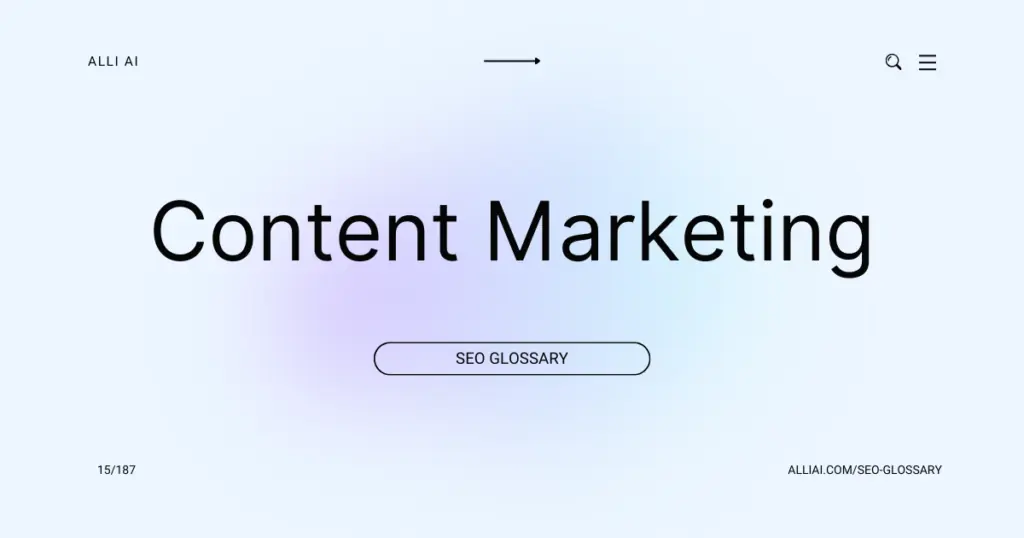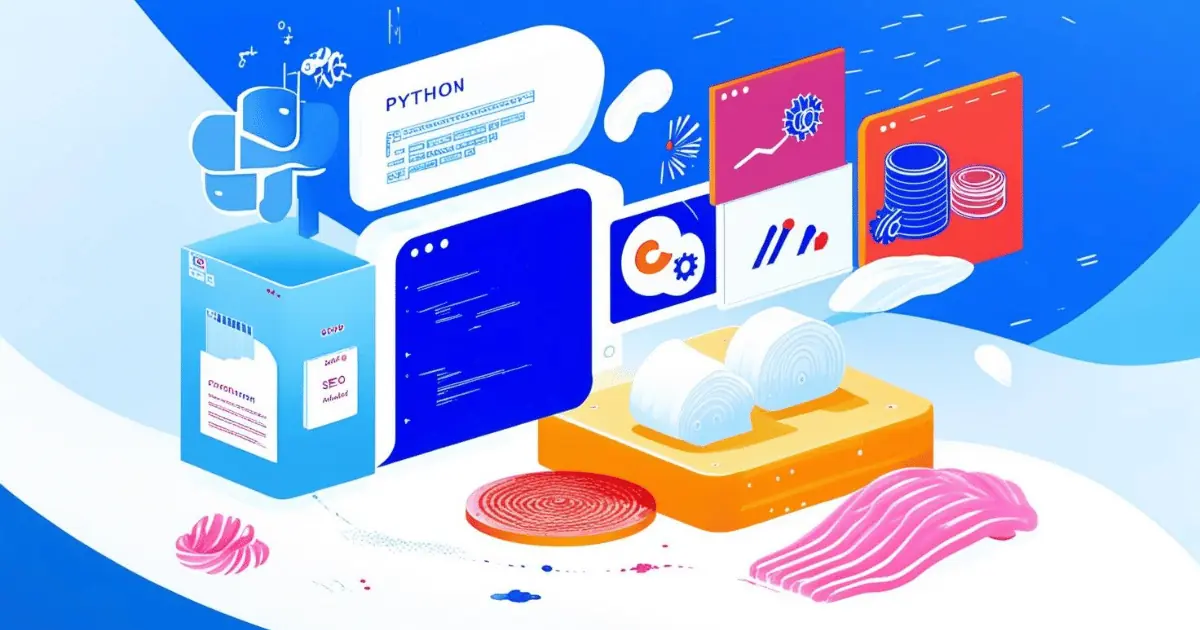What Does Content Marketing Mean?
Content marketing is a strategy used by businesses and individuals to attract, engage, and retain an audience by creating and sharing relevant articles, videos, podcasts, and other media. This approach helps establish expertise, promote brand awareness, and keep your business top of mind when it’s time to buy what you sell.
Where Does Content Marketing Fit Into The Broader SEO Landscape?
Content marketing is integral to SEO as it focuses on creating, publishing, and distributing content for a targeted audience online, influencing various aspects:
1. Keyword Integration: Effective content marketing allows for the natural integration of target keywords that are crucial for SEO, enhancing the visibility of the web pages on search engines.
2. User Engagement: High-quality, relevant content increases user engagement (time on site, low bounce rates, etc.), which is a positive signal to search engines about the value of the website.
3. Backlink Acquisition: Authoritative, informative, and engaging content attracts backlinks from other sites, which are a critical ranking factor in SEO.
4. Content Freshness: Regularly updated content keeps the site dynamic and gives search engines new content to index, which can help maintain and improve search engine rankings.
5. Ranking for Long-Tail Keywords: Content marketing allows websites to target long-tail keywords efficiently, which might not be feasible on product or landing pages.
6. Improving Site Structure: Effective content marketing contributes to a better site structure by adding relevant internal links, which helps to distribute page authority throughout the website.
7. Social Signals: Although not a direct ranking factor, content marketing can improve social media exposure, leading to increased brand awareness and potentially influencing SEO through indirect means such as increased search demand.
8. User Experience: By providing valuable content that meets the needs of the audience, content marketing improves the overall user experience, a factor that search engines consider when ranking sites.
In summary, content marketing and SEO are deeply intertwined, with each element supporting the other to increase a website’s visibility and usability.
Real Life Analogies or Metaphors to Explain Content Marketing
1. Gardening: Content marketing is like gardening. First, you plant the seeds (create content) in fertile soil (a well-defined target audience). You must nurture these seeds regularly with water and sunlight (updating content and ensuring it’s relevant), and it takes time before you see sprouts (audience engagement and lead generation). Eventually, with consistent care, the plants grow and blossom, producing fruits (conversion and sales).
2. Fishing: Imagine content marketing as fishing. Your content is the bait, and your goal is to catch fish (attract customers). Different fish are attracted to different types of bait (varied content for different audiences). You must know where to fish (choose the right platforms), what bait to use (type of content), and have patience and skill to reel in a big catch (convert leads into customers).
3. Building a Fire: In this analogy, content acts like the kindling and logs that build a fire. You start with tinder (engaging headlines) to catch the initial spark, build with kindling (high-quality articles, videos), and eventually add larger logs to keep the fire going (in-depth content, e-books, tutorials). The bigger and warmer the fire, the more people it attracts (draws in and retains a larger audience).
4. Hosting a Party: Content marketing can be likened to hosting a party. You start by sending out invitations (promoting content) to your desired guests (target audience). At the party, your conversations (content) must be engaging and interesting to ensure your guests enjoy themselves and want to come back. Having a variety of conversational topics (types of content) ensures you cater to different guests’ interests, keeping everyone engaged.
5. Beacon Lighthouse: Content marketing is like a lighthouse for ships at sea. It serves as a beacon (guides prospects), shining its light (content) to safely navigate customers to your shore (website). Your content must be strong and steady, illuminating the way amidst the vast ocean of information, helping your audience avoid hazards (poorly executed marketing strategies or misleading information) and guiding them directly to you.
How the Content Marketing Functions or is Implemented?
1. Content Strategy Development: Define goals, conduct audience research, and identify keywords to target based on audience interests and search behaviors.
2. Content Creation: Produce high-quality, engaging, and informative content that includes blog posts, videos, infographics, podcasts, and more, tailored to the specified audience and SEO guidelines.
3. Optimization: Ensure content is optimized for search engines, including proper use of keywords, meta tags, headings, and URLs, to improve visibility and ranking.
4. Publication: Release content on the company’s own platforms such as websites, blogs, or social media channels.
5. Promotion: Use SEO, email marketing, social media, and possibly paid advertising to increase the reach and visibility of the content.
6. Engagement: Encourage interaction through comments, shares, and feedback, providing a space for audience engagement to foster community and loyalty.
7. Performance Measurement: Utilize analytics tools to track traffic, engagement, conversion rates, and other relevant metrics to measure the effectiveness of the content against the goals set.
8. Iteration: Based on performance feedback, refine content strategies and production methods, repeating the process to adapt to audience needs, market changes, and technological advancements.
Impact Content Marketing has on SEO
Content Marketing significantly enhances SEO performance by boosting keyword richness, creating opportunities for inbound links, and keeping website content fresh, which encourages frequent indexing by search engines. Effective content marketing strategies improve website rankings by naturally incorporating target keywords without keyword stuffing. It also ensures a varied keyword portfolio by covering topics related to the primary keywords.
High-quality, valuable content increases user engagement by decreasing bounce rates and increasing the time on site. Moreover, shareable content expands visibility and generates backlinks, further elevating domain authority and rankings.
Content that answers user queries comprehensively can earn a position in Google’s featured snippets, leading to higher visibility in search results. This close alignment with user intent enhances user experience, ultimately improving click-through rates and conversions.
Regularly updating the website with fresh, relevant content signals to search engines that the website is current and valuable to users, thereby boosting SEO rankings. Additionally, structuring content with headers, subheaders, bullet points, and images not only aids in SEO but also improves readability and accessibility, enhancing overall user experience.
SEO Best Practices For Content Marketing
1. Keyword Research:
– Identify primary and secondary keywords relevant to the content using tools like Google Keyword Planner, SEMrush, or Ahrefs.
– Analyze search volume, keyword difficulty, and relevance.
2. Optimize Title Tags:
– Include primary keyword at the beginning of the title.
– Keep the title under 60 characters.
3. Meta Descriptions:
– Write compelling meta descriptions including primary and secondary keywords.
– Keep descriptions under 160 characters.
4. Headings and Subheadings:
– Use H1 for the main title and include the primary keyword.
– Use H2 and H3 for subheadings, incorporating secondary keywords where appropriate.
5. Content Optimization:
– Ensure content is at least 300-500 words.
– Include primary keyword in the first 100 words.
– Use secondary keywords naturally throughout the text.
– Use synonyms and long-tail variations of keywords.
6. Optimize Images:
– Use relevant images and include primary and secondary keywords in file names.
– Add descriptive alt text to images featuring keywords.
7. Internal Linking:
– Include internal links to other relevant pages on your site.
– Use descriptive anchor text that includes keywords.
8. External Linking:
– Link to authoritative external sources to enhance content credibility.
9. URL Structure:
– Include the primary keyword in the URL.
– Keep URLs short and descriptive.
10. Mobile Optimization:
– Ensure the content is mobile-friendly with responsive design.
11. Loading Speed:
– Optimize image sizes and web hosting to ensure fast loading times.
12. Content Freshness:
– Regularly update content to keep it current and relevant.
13. Schema Markup:
– Use schema markup to help search engines understand the content context better.
14. Social Sharing Buttons:
– Include social sharing buttons to encourage distribution.
15. Analytics and Tracking:
– Set up Google Analytics to track user behavior and adjust strategies based on data.
Common Mistakes To Avoid
1. Not Defining a Target Audience: Avoid this by creating detailed buyer personas and tailoring content to meet their needs and interests.
2. Ignoring SEO Best Practices: Use keyword research and SEO tools to ensure your content is discoverable.
3. Neglecting Content Quality for Quantity: Focus on producing high-quality, engaging, and informative content that adds value to the reader.
4. Failing to Promote Content: Develop a robust promotion strategy using social media, email marketing, and other relevant channels to boost visibility.
5. Skipping Content Optimization for Different Formats: Optimize content for various platforms to improve engagement and accessibility.
6. Not Utilizing Data and Feedback: Regularly analyze content performance metrics and user feedback to refine your strategy.
7. Inconsistency in Publishing: Establish and adhere to a regular publishing schedule to build audience trust and improve website traffic.
8. Overlooking the Importance of Headlines and Titles: Craft compelling headlines that accurately reflect the content and include target keywords to improve click-through rates.
9. Failing to Update Old Content: Periodically revisit and update older content to keep it relevant and SEO-friendly.
10. Lack of Strategic Content Planning: Use a content calendar to plan themes, topics, and publishing dates aligned with business goals and customer interests.
11. Not Engaging with Your Audience: Encourage and respond to comments and feedback on your content to build community and improve user engagement.
12. Missing Clear Calls to Action: Include specific, relevant calls to action in your content to guide users towards desired actions, such as subscribing or purchasing.
13. Not Leveraging Content Across Multiple Channels: Repurpose and distribute your content across different media forms and channels to maximize reach and impact.






